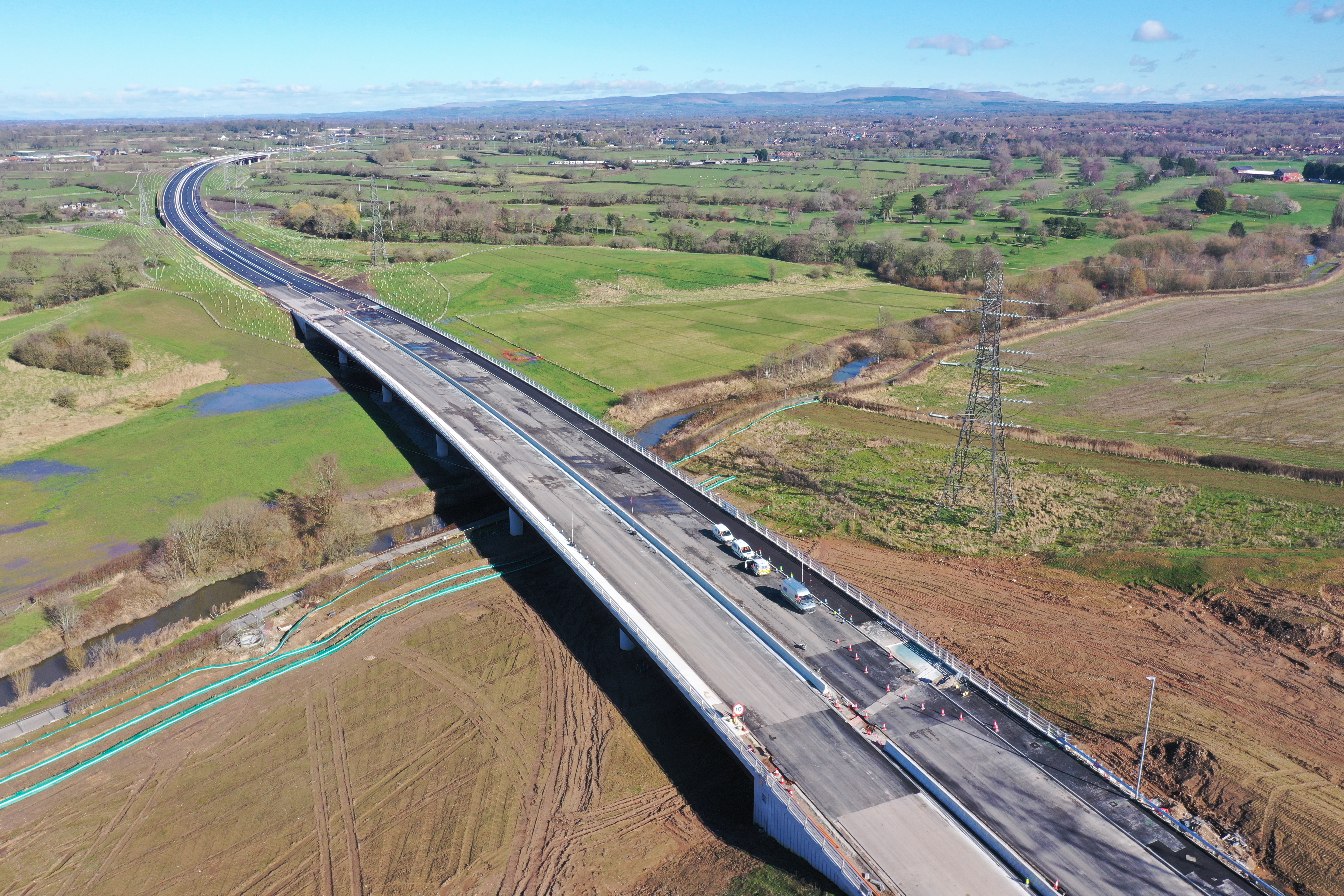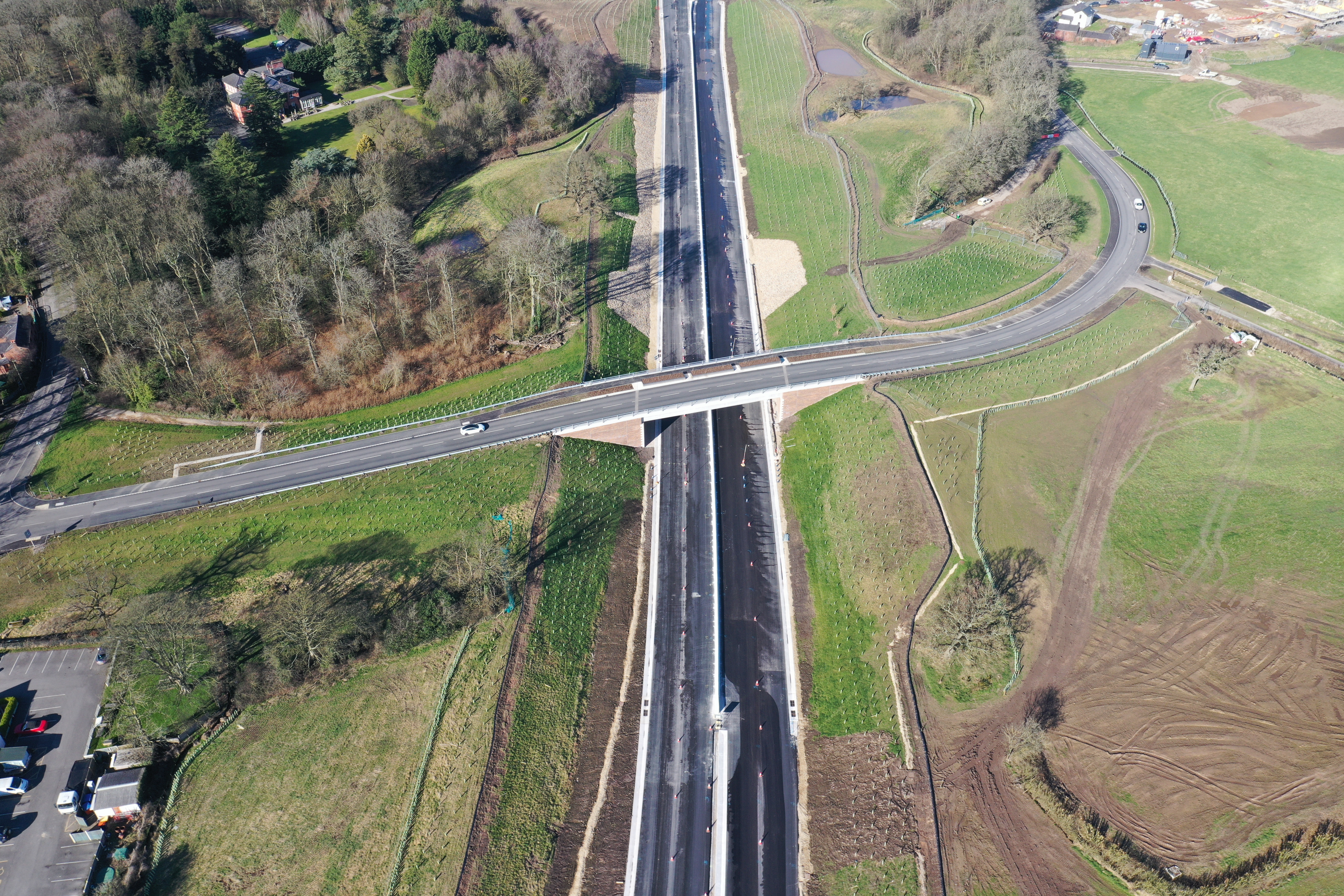
Preston Western Distributor Project
Shaping, creating and delivering a crucial road link which will reduce congestion on the road network, help communities to thrive, and open up new opportunities for workers and businesses – all against the backdrop of the Covid-19 pandemic.
- Service 1
Lancashire County Council
- Service 1
- Service 1
- Service 1
- Early Contractor Involvement – advising on buildability, value engineering, cost estimation and target cost
- Construction
- Service 1
2016 to 2023
- Service 1
Summary
The £207m Preston Western Distributor Project is the biggest new road programme in the Preston and South Ribble area. The project’s flagship new four-kilometre Edith Rigby Way dual carriageway will link Preston and southern Fylde to the M55 motorway via the A583. The scheme also includes a new motorway junction and the provision of two new link roads giving residential areas in Northwest Preston and Cottam convenient access to Edith Rigby Way.
The project, which is funded through the Preston, South Ribble and Lancashire City Deal, will improve people’s lives by providing much needed additional capacity on a heavily congested section of the local road network around Preston, boosting the local economy and enabling the construction of more than 17,000 new homes to accommodate the growing workforce in the city.

Key Benefits
1. The ECI phase was delivered on time and under the forecast budget. The construction phase concluded on time and on budget.
2. Full marks in the Considerate Constructors Scheme, with an excellent rating across categories including Respect the Community, Care for the Environment and Value their Workforce.
3. 55% of employees (including from the supply chain) came from the local area, with ten apprentices from local colleges employed on the programme.
4. We innovated to save the equivalent of 6,134 tonnes of carbon dioxide emissions during construction, which equated to financial savings of almost £7m.
5. The project delivered a 9.04% biodiversity net gain for habitats and a 10.81% net gain for hedgerows.
Early contractor involvement
The Early Contractor Involvement phase began in 2016, three years before construction started, giving Lancashire County Council cost and programme certainty by providing services including commercial management, value engineering advice, planning and project controls and stakeholder engagement. This ensured the scheme moved from concept to a buildable project that gained planning consent.
We proactively facilitated a collaborative programme of engagement between organisations and stakeholders to accelerate and assure delivery of the construction phase. We involved statutory undertakers in the planning process, including Network Rail, National Highways (then Highways England), the Environment Agency and relevant third parties, such as the train operating companies serving the Preston to Blackpool line and utilities providers. During the planning process and application, the team engaged with the community and road users at public consultation, providing detailed information about the plans for the scheme and the opportunity for feedback.
We developed a dynamic programme plan based on engineering data about the structures, materials and environment, which allowed us to forecast progress, identify interdependencies and expenditure on a monthly basis. This approach allowed us to ensure the construction phase was delivered to budget by identifying potential challenges in delivery and enabling a planned, proactive response.
Our approach to the environment encapsulates this way of working: the required Natural England licences were put in place during the ECI phase, enabling surveys to start ahead of the formal start of construction, without the need to wait for the next ecological season. This saved between three and six months on the programme and enabled highly critical third-party access to the site.

Construction
The scheme consists of the construction of:
- A new motorway junction: the M55 Junction 2, comprising four slip roads, one bridge crossing the motorway and two roundabouts giving access to the West of Preston.
- Three new roads:
- Edith Rigby Way dual carriageway (2.5 miles).
- The William Young Way East-West link Road (2 miles).
- The Avice Pimlett Way Cottam Link Road (0.4 miles).
- Three underpasses.
- Two viaducts.
- Bartle Lane overbridge.
Complex engineering
We deployed innovative engineering techniques to ensure that we delivered on time and on budget, despite the complexities of the project. The construction of the 278-metre-long Savick Viaduct is a key example of this approach. The rest of the programme was dependent on the team delivering this significant milestone on schedule – despite it spanning a brook and a floodplain, with power cables close by. To ensure the milestone was met on time, we worked closely with a specialist supplier to devise the most efficient way of installing the steel beams used to build this impressive new structure. We carried out as much preparatory work as we could offsite, such as the permanent formwork and falsework, processes which strengthen the load-bearing capabilities of the beams. The beams were then moved into position using self-propelled modular transport and finally lifted into place. This process saved £1m and we significantly reduced the amount of time which the engineers spent in safety critical environments.
The ground conditions across the project were challenging. At Savick Viaduct, we had to carry out extensive additional temporary works, such as installing working platforms and deploying vacuum drainage solutions to stabilise the ground before beginning the main works. This was technically challenging and required extensive stakeholder engagement, including with the Environment Agency. This process allowed us to stabilise the ground conditions sufficiently to drive the piling 40 metres beneath the ground.
Another prominent example of the project’s complexity is the newly built Lea Viaduct which spans the electrified Preston to Blackpool railway line and a canal. In this case, our in-house survey team used 3D modelling techniques and geotechnical analysis to model the effect of the planned works on the railway and the Overhead Line Equipment. The team successfully demonstrated that any forecast ground movement due to the planned works would remain within acceptable limits.
This complex engineering project also required integration with existing transport and utilities infrastructure. Our solutions minimised disruption to the travelling public, while reducing time, cost and risk associated with the works. Over the course of two nighttime motorway closures in June 2021, we installed the 130-tonne, 48-metre-long Becconsall Bridge over the M55, enhancing local connectivity by creating a brand-new junction.
At Savick Viaduct, two large sewers servicing North West Preston passed beneath the area identified for this new structure. We conducted vibration monitoring surveys to ensure that we mitigated any risk to these assets appropriately ahead of construction through the detailed design and enabling works. During construction, we used reinforced concrete slabs onsite.
Working closely with Network Rail, our concrete supplier and temporary works designers, we used a Production Thinking approach to deliver all enabling works for the 233-metre-long Lea Viaduct offsite and lift the new structure into place once in situ. Agreed planned closures of the railway took place on Christmas Day and Boxing Day 2020.

Environment
Working in sympathy with the environment was a critical priority for us and we worked hard to improve biodiversity and reduce carbon emissions. Ecology and nature conservation were important considerations for the project. The landscape plans for the scheme were designed to restore farmland and to protect and enhance habitats for species including great crested newts, bats, birds, brown hare, hedgehogs and common toads. We designed the landscape to create a 9.04% net gain for habitats and a 10.81% net gain for hedgerows.
During the earthworks, we removed 600,000 cubic metres of sub and topsoil. Rather than removing this material from site and causing significant congestion to the local road network, we kept 100% of the earth removed onsite. Working with our customer, we made a feature of the remodelled landscape with all earth relocated to the roadside, where it has been replanted with trees and serves both as a visual point of interest and as a noise barrier. This approach removed 20,000 journeys of 60 miles each from the local road network.
We used 100% renewable electricity to power onsite works, and we explored other sources of clean energy, such as HVO and the use of hydrogen. This included working with hydrogen start-up Hydrologiq to trial the use of a hydrogen-powered fuel cell generator at the M55 compound, where together we demonstrated that green hydrogen would remove almost all carbon emissions associated with onsite operations.
We evaluated telematics data to identify opportunities to reduce plant idling – through a concerted programme of behaviour change and by working in close step with our supply chain, we reduced plant idling by approximately 20%. Diesel usage was eliminated across the project, replacing this with Hydrotreated Vegetable Oil (HVO) fuel manufactured from sustainable, renewable feedstocks.
Social value
Our approach to social value was grounded in the desire to maximise the value of work placed with local businesses and for local people. The project team ensured that the local economy benefitted from the investment in the Preston Western Distributor Project in several ways:
- We awarded work on the project to companies in the local supply chain wherever possible, with 45% of project spend being invested within a 25-mile radius of the site, with an additional 37% spent within 25 to 100 miles.
- We recruited extensively from the local area, with 58% of the workforce based in the community.
- As part of our Lancashire Skills Pledge, we supported Preston College’s T levels programme by providing student placements across several disciplines and worked with local schools to engage students with the potential of a STEM career.
- We took on ten apprentices throughout the project, creating early careers opportunities in engineering and construction.

Phill Wilson, Project Manager, Lancashire County Council, said: “Costain has played a vital part in the development, design and construction process for the Preston Western Distributor Project from commencing their involvement in 2016. This project has been an excellent example of how finding the right partner though the Early Contractor Involvement process can produce the cooperative team necessary for such a complex and challenging project.”
Contact and social
Aviation and integrated transport
